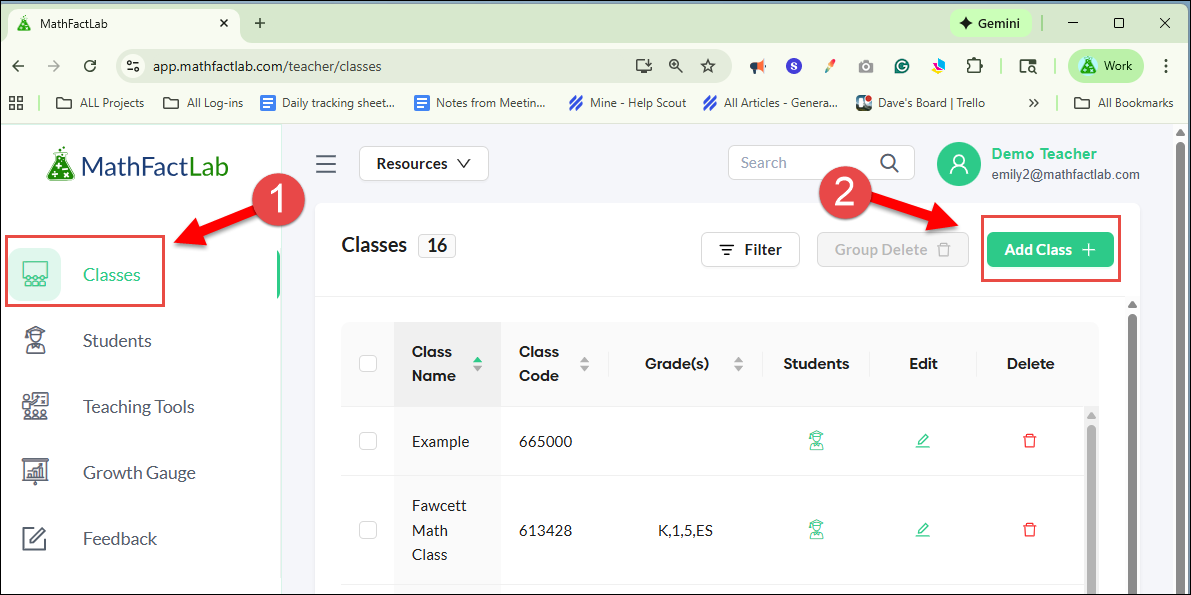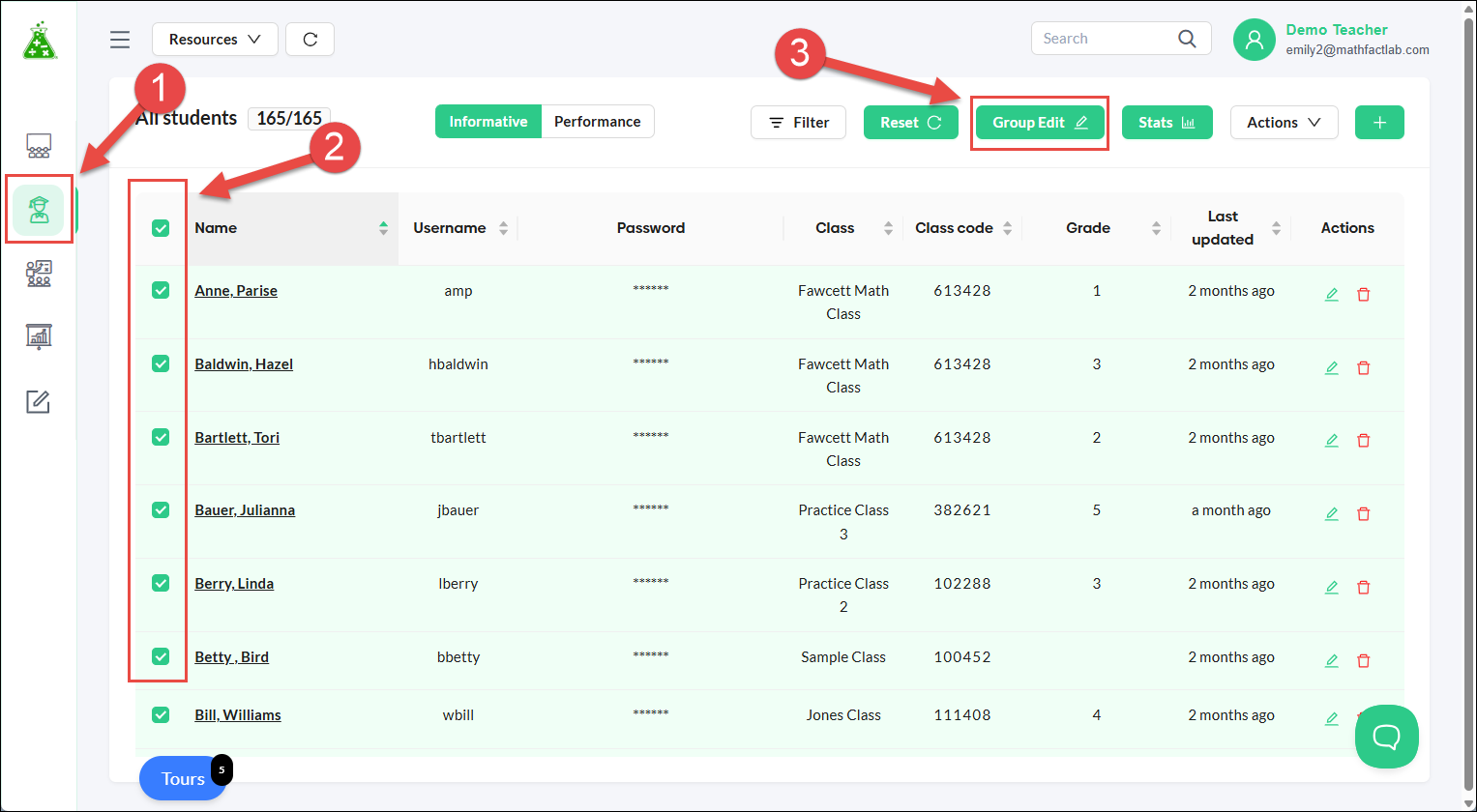Quick-Start Guide to Teacher Accounts
This guide provides guidance to help teachers get started with MathFactLab right away.
Step 5: Students Log in, Take Placement Tests, and Begin Program
Step 6: Monitoring Progress and Making Adjustments
Brief Overview of MathFactLab
- MathFactLab offers students two learning modes: Addition/Subtraction and Multiplication/Division. Which learning mode your students work on is determined by you. In both modes, students work through a series of levels, which we call Progress Tables.
- Students take a placement test when they first begin MathFactLab. Once completed, students are assigned to a level within the program. At each level, students are presented with a menu of activities to choose from. These activities allow students to practice the newly introduced fact families of that level using a variety of models and strategies. Review of previous levels is built in at every level.
- When students have demonstrated sufficient practice at a given level, they have the opportunity to take the 'Level Lifter' assessment to see if they are ready for the next level. If they pass, they progress to the next level; if not, they continue on the same level but can focus on the strategies/models that work best for them.
Step 1: Creating a Class
To add students, you will first need to create a class (or multiple classes).
To create a class:
- Select the Classes tab.
- Click the 'Add Class +' button and complete the required form.

Complete step-by-step instructions for adding classes can be found here.
If you have a Google Classroom account, you will see the option to 'Upload class list from Classroom.' A detailed explanation for this process can be found in this document.
Step 2: Adding Students
Once you create your class(es), it's time to add students (unless you synced with Classroom).
You'll find the options for adding students by selecting the Students tab and hovering over the green + button in the top right.

There are three ways to add students:
- Add students one at a time. Select 'Add Single Student'.
- Add multiple students at once by copying/pasting a class list. Select 'Add Multiple Students'.
- Import your students by uploading a spreadsheet. Select 'Bulk Student Import'.
This help doc article goes over adding students in greater detail.
Step 3: Login Cards
Logging in for the first time will go much easier for students if they have login cards.
To generate login cards:
- Go to the Students tab.
- Click the 'Actions' button in the top right.
- Select 'Generate Login Cards'.

Detailed information about login cards and how to create them can be found in this document.
Step 4: Group Edits
If you wish to make changes to all or many student settings at once, you'll want to use the 'Group Edit' tool. This tool allows you to change:
- The Student Learning Mode: Either addition/subtraction or multiplication/division.
- The Required Fluency Rate: The number of seconds in which a student has to respond to be considered fluent
- Passing Percentage: The percentage score students need to pass a Level Lifter.
- Session Length: How many minutes a student session is (from 5 to 20).
- In Group Edit, you can also change class assignments, grade level, preferred language, and several other settings.
To make a group edit:
- Go to the Students tab.
- Either select students individually by clicking their checkboxes or click the checkbox in the header row to select all students.
- Click the 'Group Edit' button.

This help doc goes over group edits in greater detail.
Step 5: Students Watch Intro Video, Log in, Take Placement Test, and Begin Program
Now it's almost time for your students to log in.
- Before they do so, show them this introductory video: Student Introduction Part I.
- Provide students with their login cards and ask them to go to app.mathfactlab.com. Younger students will certainly need some help with this process, and it may be best to do this in small groups or individually. Once logged in, we suggest allowing the browser to save login credentials; this will make the process much easier next time. Bookmarking the site will also facilitate things.
- When the students first log in, they will read through a very brief welcome, after which they will be given a placement test.
- Once the placement test is complete, students will be assigned to a level within the program and will immediately begin working through activities at that level.
The next day, before students log in for the second time, show them our Student Introduction to MathFactLab Part II. This explains the Level Lifter assessment and what happens if students do or do not pass it.
To better familiarize yourself with the MathFactLab student experience, we encourage you, the teacher, to watch this brief video.
Step 6: Monitoring Progress and Making Adjustments
Your teacher dashboard will allow you to keep track of your students' levels, activity, and progress. It will also allow you to make changes to settings to better meet individual student needs.
The video below will give you a solid overview of the tools available to you on the teacher dashboard.
- To learn all about our reports, click here.
- This help doc and/or this video will help you differentiate to better meet student needs.
- This help doc will show you how to use MathFactLab for direct instruction.
- Click here to see our entire portfolio of video tutorials.
We wish you and your students all the best with MathFactLab. Please be in touch with any questions, issues, or suggestions.